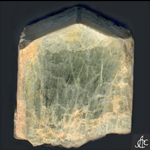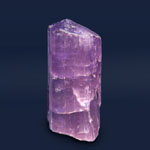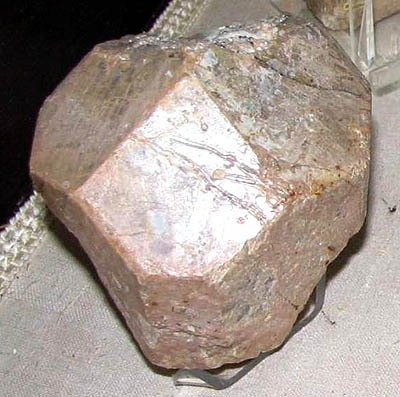Faldshpathoids (silicates): Scapolite
 Diagnostic card.
Diagnostic card.
On the picture. Scapolite of prismatic appearance from Arendal, Norway.
(Na, Ca) 8 (Cl 2 , SO 4 , CO 3 ) (Al Si 3 O 8 ) 6
Tsingonia tetragonal
Hardness 5-6,5
Specific weight 2.54-2.77
Cleavage is easily manifested
Cracked shell
Color is colorless, differently colored
Color in powder white
Glitter glass

Glitter is glassy, often there is a pink or purple cat's eye. In 1975, a violet variety (baking) was discovered in East Africa. It occurs in Upper Burma, Brazil (Espiritu Santo), Madagascar, Tanzania. It can be confused with ambligonite, chrysoberyl, golden beryl.
Scapolite (vernerite) is a solid solution, the extreme members of which are marialite (containing sodium only) and meionite (containing only calcium). Both these minerals in pure form are not found in nature.
Scapolite crystallizes as well-formed individual prismatic crystals. It is allochromatically colored, that is, it can have a variety of colors (from yellow to violet, pink, blue, green, orange); Tonality is always somewhat weakened. Mineral has good, and sometimes excellent transparency. Scapolite is quite hard, its gloss is glassy. It easily shows cleavage in two directions, a fracture in it is conchoidal. Some specimens have the effect of iridescent coloring due to minute inclusions, visible only under a microscope.
Scapolite is a group of sodium and calcium aluminosilicates with a variable composition. Not surprisingly, the color of the mineral is also variable. The chemical composition is a mixture of marialite Na4 [AlSi2O8] 3 Cl and meionite Ca4 [Al2Si2O8] 3 CO3 minerals; The amount of SiO2 decreases as the content of the meionite part increases from 56 to 47%; The content of meyonite (in%) is: marialite 0-10; Vernerite 10-40; Mizzonite 40-60; Dipyr 60-90; Muonite 90-100. Tetragonal-dipyramidal form of symmetry. Cleavage is the mean of (100), imperfect in (110). It occurs in the form of elongated prismatic crystals with the most developed facets of prisms (100), (110), (210) blunted by dipyramids (111), (131), (331). Grain aggregates of a sixth-order structure are also noted, more rarely dense, draining masses.
Crystals scapolite straw-yellow shade called stroganovity. Blue scapolites are called glavcoliths (glaucolites). There are also pink, yellow, orange, red, purple and brown stones. There are also colorless crystals. Scapolites have dichroism - their color varies depending on the angle of view. In addition, there are stones with the effect of "cat's eye."
Diagnostic signs.
Under the influence of ultraviolet rays, this silicate can exhibit intense fluorescence in the yellow-orange range.
Origin.
Scapolite is most often found in metamorphic rocks of medium and high degree of metamorphism, formed primarily by carbonate rocks (limestones, dolomites, marbles). In marbles and carbonate schists, it is mostly present in association with numerous minerals, such as calcite, quartz, diopside, vesuvian and others. Scapolites are also found in granulite rocks, pegmatites and, more rarely, in crystalline schists, sometimes associated with iron ore deposits.
Place of Birth.
In Italy, the scapolite is found in the Adamello massif, in various places in Val Malenco and in the upper Vattelina, on the island of Elba, and also in the form of elongated crystal clear crystals in the products of the eruptions of Vesuvius. Outside Italy, this mineral is found in Bavaria (Germany), Carinthia (Austria) and various locations on the Scandinavian Peninsula. Other deposits are in the area of Lake Superior in the United States. Mineral, suitable for cutting, is available in Madagascar, Tanzania, as well as in Anonio-Coelu in Brazil, and specimens with an iridescent coloring come from Burma. Sometimes there are giant crystals, reaching a half-meter in length, but their dignity is small. In addition to Burma, scapolites are found in Kenya and Tanzania, in Brazil, in Madagascar, in the Eastern Pamirs, in Tajikistan and in the Canadian province of Quebec.
Application in jewelry.
Very transparent and elongated crystals of this mineral are cut by an oval or in a quadrilateral, and having inclusions - in a cabochon. Because of its low strength, the scapolite is not widely used in jewelry. Yellow and purple scapolite is very similar to citrine and amethyst.




Scapolite (meionite). Madagascar. Photo: © А.А. Evseev.
- Ghetchellit - "New Almaden blend" - arsenide and antimony sulfide (modern sulfosol)
- Antimony is a toxic metal (semimetal) , widely used in metallurgy, medicine and engineering
- Zirconium - a rare and undiscovered metal and the most dangerous precious stone in oxide and salt
- Gold - yellow dangerous and poisonous metal of modern accurate digital and cable technologies
- Sulfur is a golden-yellow toxic substance and a sign of active volcanic activity
- Cadmium is an undisputed toxic silvery metal unknown to a wide range of people
- Lead - a toxic gray imitator of metallic silver and toxic metal blende
- Arsenic is a classic poison of medieval and modern poisoners and medicine in medicine
Poisonous and radioactive dangerous stones and minerals
** - poisonous stones and minerals (mandatory check in the chemical laboratory + explicit indication of toxicity)
** - radioactive stones and minerals (mandatory check on the standard dosimeter + ban on open sales in case of radioactivity exceeding 24 milli / g / h + additional measures of population protection)
Catalog of minerals and semi-precious stones of the world by groups
** - poisonous stones and minerals
** - radioactive stones and minerals


Comments
When commenting on, remember that the content and tone of your message can hurt the feelings of real people, show respect and tolerance to your interlocutors even if you do not share their opinion, your behavior in the conditions of freedom of expression and anonymity provided by the Internet, changes Not only virtual, but also the real world. All comments are hidden from the index, spam is controlled.